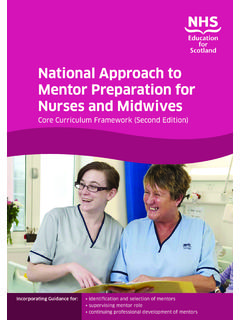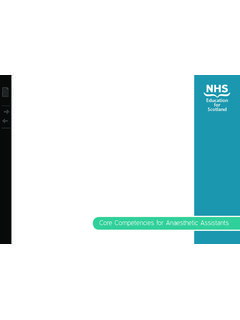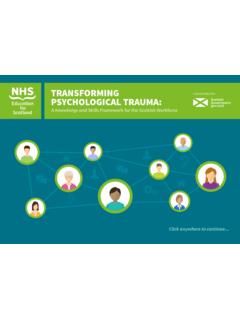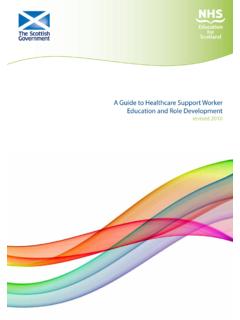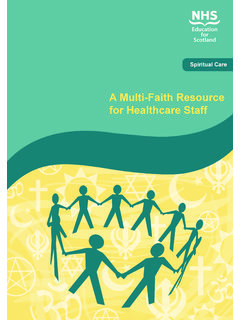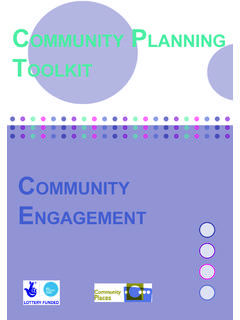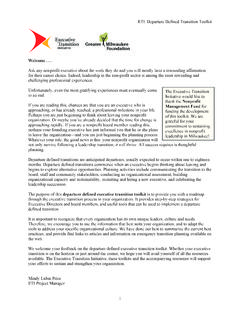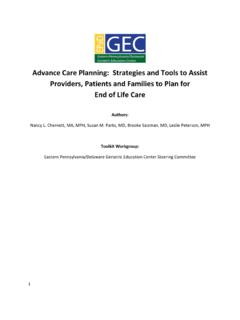Transcription of Second Edition - NES
1 Nursing and Midwifery Workload and Workforce planning Learning toolkit | 1 Nursing and Midwifery Workload and Workforce PlanningLearning toolkit ( Second Edition )Nursing and Midwifery Workload and Workforce PlanningLearning ToolkitSecond EditionPublished January 20132 | Nursing and Midwifery Workload and Workforce planning Learning ToolkitContents 1. Introduction 52. Measuring Workload 11 Learning outcomes 12 Introduction to nursing and midwifery workload 13 Approaches to workload measurement 15 Interpreting and applying workload data 25 Work-based learning activities (1-3) 293. Workforce planning and Staff Deployment 31 Learning outcomes 32 Introduction to workforce planning and staff deployment 33 Skill mix 36 planning and managing staff resources 43 People management 52 Working in partnership with your HR department 58 Nursing and midwifery budgets/financial management 61 Long-term planning 66 Work-based learning activities (4-10) 704.
2 Support materials 73 Case studies (1-8) 74 Worksheets (1-6) 80 Handouts (1-5) 865. References 956. Acknowledgements 101 Nursing and Midwifery Workload and Workforce planning Learning toolkit | 3 Foreword Welcome to the Second Edition of the Nursing and Midwifery Workload and Workforce planning Learning skills and knowledge of Nursing and Midwifery staff continue to be crucial to the delivery of safe, effective and person-centred health services in Scotland, and the relative size of the nursing and midwifery workforce means it has a crucial impact upon healthcare provision (Audit Scotland, 2007). Effective use of this important human resource is therefore essential, and the first Edition of the learning toolkit supported Senior Charge Nurses, to understand workforce planning and to support the robust workload measurement tools in use across addition Releasing Time to Care has been introduced across Boards, further strengthening the impact Senior Charge Nurses (SCN) Senior Charge Midwives (SCM) and Team Leaders (TL) have on the processes to increase direct patient care time within inpatient and community areas.
3 However, there have been some significant changes within NHSS cotland since the first Edition of the Learning toolkit was published; the current economic climate means increased pressure on NHS Boards to improve efficiency; and, alongside this, high profile reports and investigations into concerns about care have meant nursing workforce numbers and models of care provision are under increased this challenging context, the Scottish Government has set out the Healthcare Quality Strategy, focussing on safe, effective and person centred care and, in 2012, the Nursing and Midwifery Workload and Workforce planning tools were mandated as part of the workforce planning process across NHS Scotland. This further highlighted the importance of effective use of the workload tools as part of a triangulated approach to determine nursing and midwifery staffing establishments within all areas of service (CEL 32).
4 In Leading Better Care Report of the Senior Charge Nurse Review and Clinical Quality Indicators Project (Scottish Government, 2008), the four dimensions of the SCN role were outlined and Managing and developing team performance (Dimension 3) relates to the use of resources and workforce planning within the practice setting, SCNs, SCMs and TLs shape the ethos, values and effectiveness of their wards and departments and are instrumental in providing the highest possible care for patients. As leaders on the front line, they are; the visible embodiment of clinical leadership in NHS settings, co-ordinating patient care, marshalling and inspiring the nursing or midwifery team and advocating on patients behalf with members of the multidisciplinary team. (Scottish Government 2008). That s why it s important they can understand and use the tools and are equipped with the skills to lead their teams and manage their resources effectively and Moore Dr Colette Ferguson 4 | Nursing and Midwifery Workload and Workforce planning Learning ToolkitThe toolkit has previously been used throughout NHS Scotland in a variety of ways; as part of Leading Better Care development and independently as a module used to develop those managing teams of nurses, with several Universities accrediting these at SCQF level 9.
5 Alongside the focus on developing SCNs, SCMs and TLs, feedback from users highlighted a desire for the resource to be targeted to a wider audience and suggested enhanced chapters on the following; Finance, Working with HR, Skill Mix and Rostering. Therefore, this revised Second Edition of the Learning toolkit is designed to be suitable for those managing SCNs, SCMs and TLs as well as those aspiring to reach that feedback also suggested that the toolkit worked most effectively when delivered with executive team sponsorship, skilled facilitation from practice development and organisational development and engagement with key staff from within the organisation, such as finance and human resources. Providing information, web links, case studies and exercises from a variety of care settings this toolkit will enable SCNs, SCMs and TLs to embrace the role, ensuring that the resources they are responsible and accountable for are used most effectively.
6 We see this toolkit as one, of a range of supporting resources for this group of staff, and can be used in conjunction with the Education and Development Framework for Senior Charge Nurses/Midwives and Team Leaders in All Areas of Practice ( Second Edition ) (NES, 2012). As modes of care provision and settings change, it is imperative we continue to refresh the workload tools to reflect this. The Nursing and Midwifery Workload and Workforce planning Project team, in conjunction with NHS Education for Scotland, will review and monitor these changes; adapting and enhancing the Learning toolkit as required, thus ensuring appropriate training and guidance for practitioners. We are confident that professional leaders, equipped with workforce and workload skills, can ensure that they have the right staff at the right place with the right skills at the right time, enabling person centred, safe and effective care.
7 Finally, we would like to thank colleagues across the NHS, who have contributed to he development and revision of this toolkit and commend it to you. Dr Colette Ferguson Ros Moore Director of Nursing, Midwifery Chief Nursing Officerand Allied Health Professions CNO Directorate,NHS Education for Scotland Scottish Government Nursing and Midwifery Workload and Workforce planning Learning toolkit | 5 1. Introduction 6 | Nursing and Midwifery Workload and Workforce planning Learning ToolkitThe Nursing and Midwifery Workload and Workforce planning toolkit was published in 2008 as a work-based guide to support the workforce planning issues that are relevant to Senior Charge Nurses (SCNs), Senior Charge Midwives (SCMs), Team Leaders (TLs) and others who contribute to nursing and midwifery workforce planning . The toolkit may also be a useful development resource for aspiring SCNs, SCMs and TLs, and a revision or refresher tool for non-clinical managers who manage clinical teams.
8 This Second Edition has been refreshed to reflect current thinking and policy, including a stronger community emphasis. Throughout the document, comments are included from an evaluation of the toolkit conducted by NHS Education for Scotland (NES), a stakeholder event held in September 2011, and feedback from NHS Boards and users, all of which have helped inform and shape this new is the toolkit for? This toolkit offers SCNs, SCMs, TLs and their managers the opportunity to develop their understanding of workload and workforce planning and help them use workload measurement tools effectively. It provides background information, learning activities and support materials to assist NHS Boards in planning and delivering programmes of learning for nursing and midwifery staff. Such programmes should be tailored to meet the needs of the specific staff of the toolkit The toolkit has two main sections covering: 1 Measuring workload 2 Workforce planning and staff deployment Each section contains learning outcomes, key content and learning activities.
9 Ideas for work-based activities are given at the end of each section. Support materials, including case studies, worksheets and handouts, are given in section 4. How should the toolkit be used? It is intended as a flexible resource for those who have responsibility for learning and development within NHS organisations, as well as a course handbook for those participating in programmes of learning. The toolkit could also be used as a self-directed learning resource or revision tool. As a facilitator this has heightened my own awareness of the tools involved and through participant engagement has enhanced my knowledge within this clinical field, whilst developing new learning that I will be able to disseminate and share with new groups applying the principles and Midwifery Workload and Workforce planning Learning toolkit | 7 It is envisaged however, that attending workshops and networking events will be one of the main benefits of participating in a planned programme of learning, as these will provide time and thinking space among like minded people and an opportunity to share ideas, experiences and learning.
10 The various learning and activities will facilitate application of knowledge to clinical practice, and can be selected to suit different levels of practice. Some activities may be undertaken during a workshop and others have been developed for use in the workplace. These can help professional development through reflection on practice. Worksheet 1 (page 80) which can be used to record learning activities and evidence learning, and can help provide evidence for KSF Development Review, Personal Development planning and of SCNs, SCMs and TLs in workload and workforce planning SCNs, SCMs and TLs have an important contribution to make to workload and workforce planning . A workforce plan can be prepared on many levels, from the simple to the complex. Examples include the staff roster prepared once a month to ensure that all shifts are covered by staff with the correct skills and competences to ensure that patient services are delivered safely, or it could be the NHS Board s workforce plan which pulls together the workforce needed to deliver the services at a local level.
